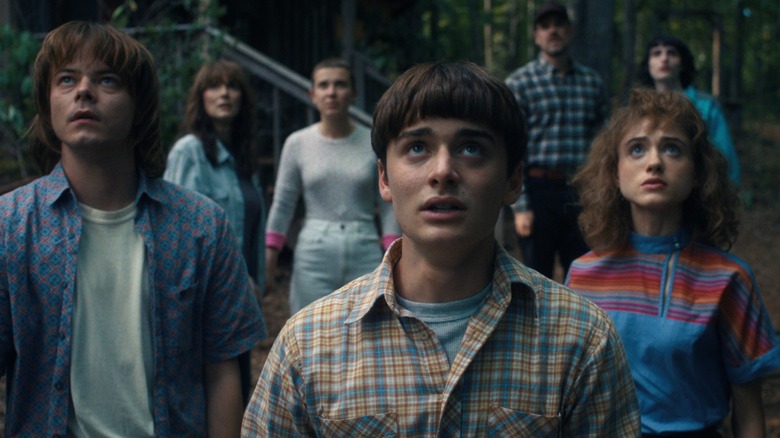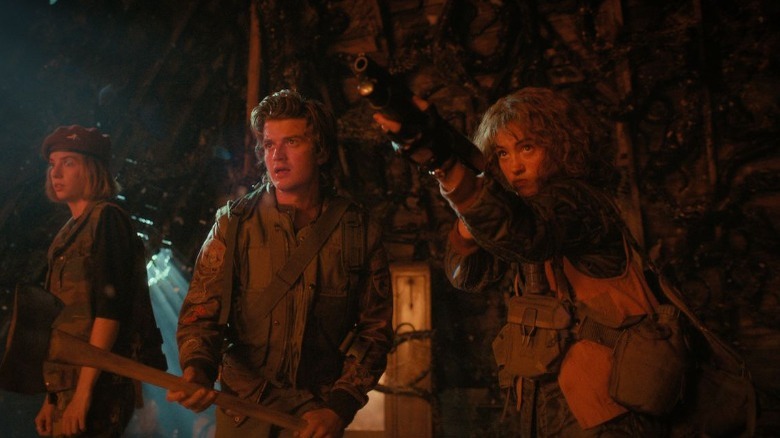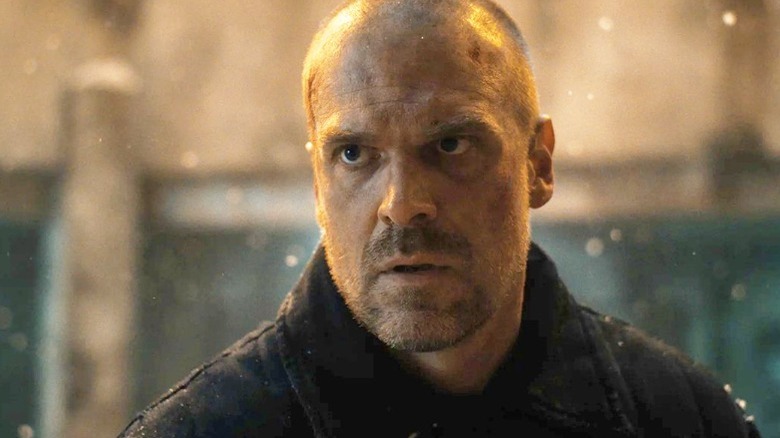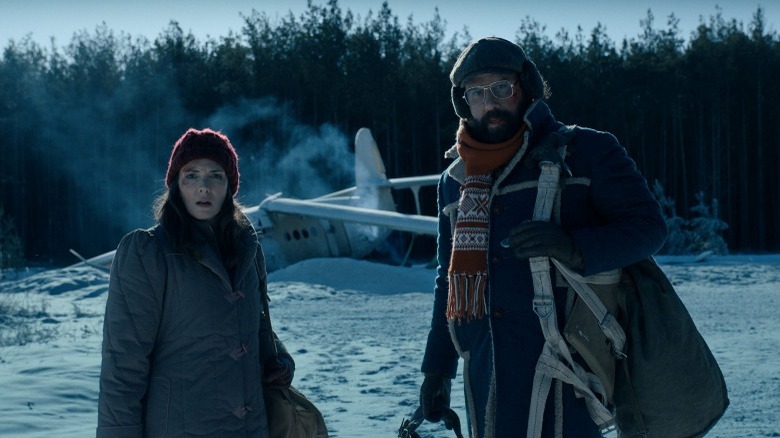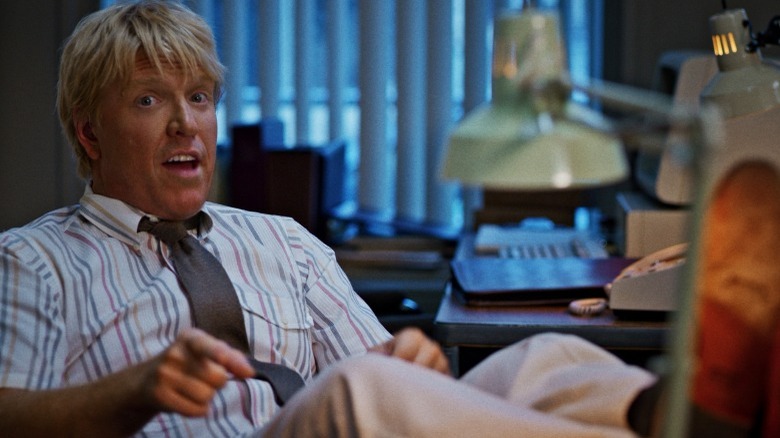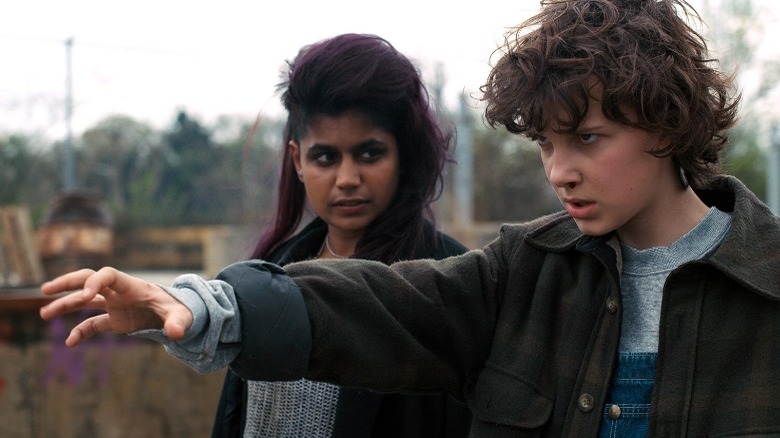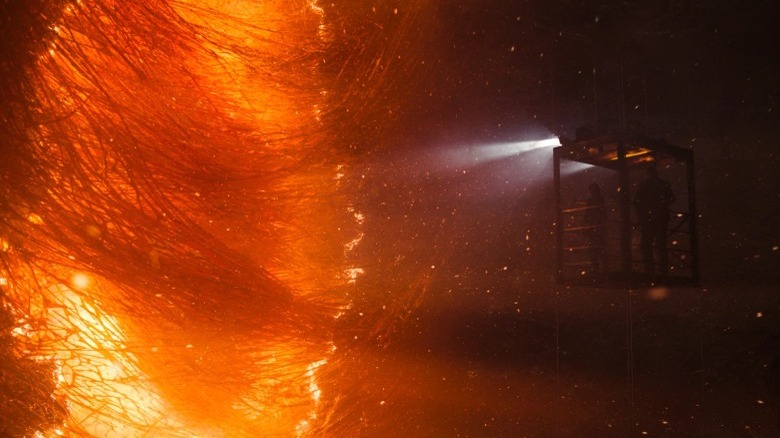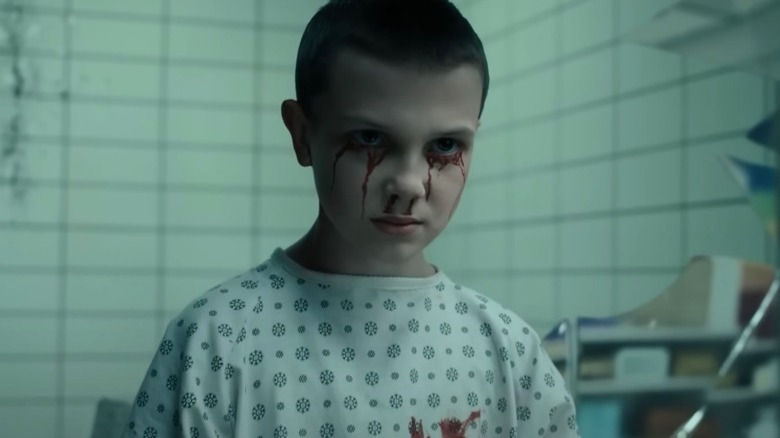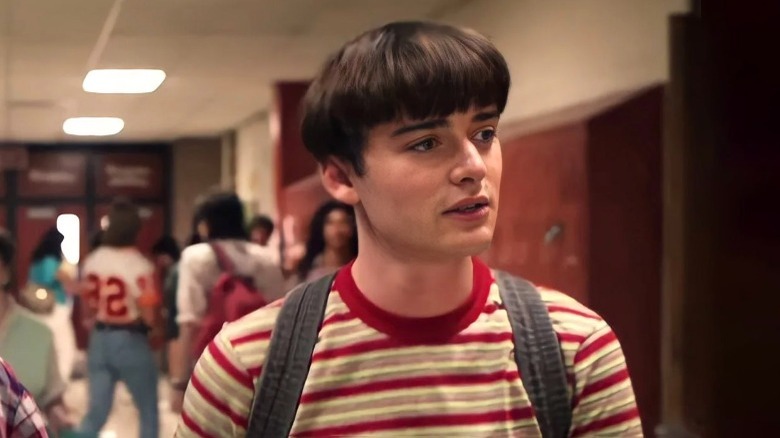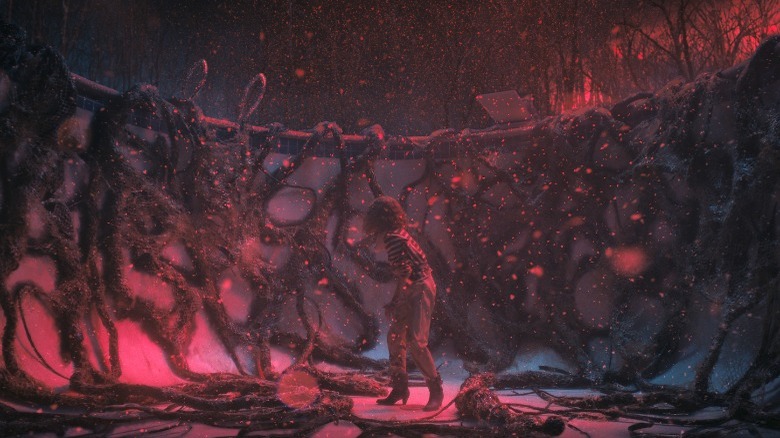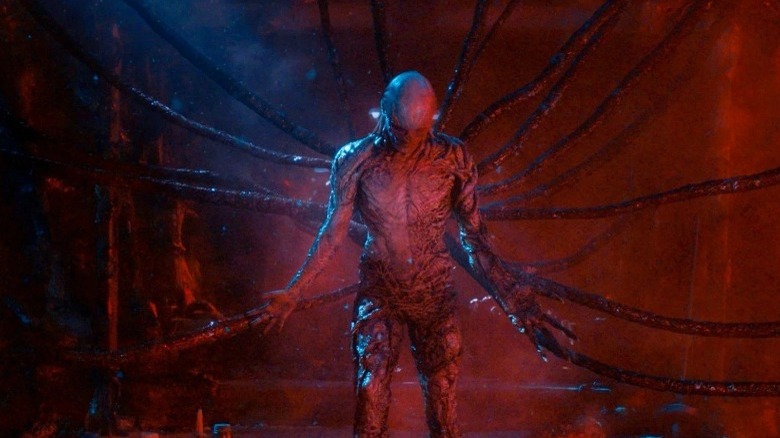Stranger Things Plot Holes That Still Confuse Fans
"Stranger Things" has been a remarkable success. When it premiered in 2016 on Netflix, the landscape of streaming was radically different than it is now. The platform took a big risk with the Duffer brothers' sci-fi horror hybrid, yet it's paid dividends. Remarkably patient and exceptionally well-crafted, "Stranger Things" represents the best of what digital convergence can bring: a big show with big ideas that swings for the fences and hits every single time.
While "Stranger Things" hasn't been without its controversies, it remains one of the streaming giant's biggest draws. A forthcoming fifth season is poised to be the original venture's last, with "Stranger Things" going the "House of the Dragon" route of spin-offs and dovetailing narratives. Key to the show's success is its unqualified commitment to its characters and worldbuilding. Centered on an alternate dimension dubbed the Upside Down, "Stranger Things" has excelled at slowly unfurling the scope of its world, with each new season introducing horrific monsters and threats that build on what's come before. That doesn't mean it has all worked, however, and like most science fiction properties, "Stranger Things" has stumbled with a plot hole or two. While suspending disbelief is part and parcel of the genre, these moments stand out in large part because of how consistently tight the show's plotting is.
Season 4's escape from the Upside Down
Season 4 was "Stranger Things'" darkest and most shocking season yet. It was a remarkable accomplishment, with every member of the cast at the top of their game. Better still, the introduction of antagonist Vecna (Jamie Campbell Bower) is one of the best decisions the show has made. To cap the season, Sadie Sink's Max is once again threatened by Vecna's powers. She is brutally thrown about, her extremities snapped like pretzel rods, and for a beat, it looks as though Max might genuinely die — and for a moment, she does.
Luckily, Eleven (Millie Bobby Brown) and Lucas (Caleb McLaughlin) are there to save the day. Additionally, Nancy (Natalia Dyer), Steve (Joe Keery), Robin (Maya Hawke), and Dustin (Gaten Matarazzo) are there in the Upside Down to confront Vecna head-on. At the cusp of Max's death, the Hawkins gates expand, tearing a rift through the town. However, as Eleven saves Max, those rifts close, preventing a full-borne apocalypse for another day. Yet, the closing of the gates should, in theory, have trapped the quartet of Hawkins teens in the Upside Down. The finale flashes forward two days, completely skipping over the genuinely confounding escape. They simply reappear, packing boxes and making sandwiches. It defies not only the show's internal logic but the season's. Season 4 spent an enormous amount of time exploring the rules of the Upside Down, only to toss them aside for convenience.
Hopper's Season 4 injuries
"Stranger Things" took a bold risk in not only splitting its fourth season into two parts but in splitting its narrative into three and at times, four distinct threads. There's the Russian prison fiasco with Hopper (David Harbour), the California plot, the Hawkins plot, and a separate mid-season arc focusing on Eleven. That's not innately a bad thing, and for the most part, "Stranger Things" handles it with aplomb. Still, the Russia scenes are arguably the weakest, largely because of how tonally and narratively disconnected from the rest of the season they seem.
The Russia scenes are grim. "Stranger Things" not only problematically traded in real-life tragedies for the subplot, but the violence contained there is considerably more visceral and direct than it has been anywhere else in the series. To free himself from the labor camp, Hopper enlists another prisoner to break his ankle with a hammer, allowing him to easily slip in and out of his chains. It's a bone-crunching, painful scene, and yes, Hopper tests his theory successfully in his cell later that night. The only problem is that Hopper never again exhibits any kind of injury. Shattering an ankle with a spike maul isn't a superfluous wound. By all accounts, Hopper should be immobile. As the arc progresses, Hopper is running barefoot, bouncing around, and dodging Demogorgons like a stunt maestro. Hopper becomes a real-life superhero, stretching the show's credulity to frustrating lengths.
Joyce leaves for Russia
To be fair, a character acting illogically or out of turn does not a plot hole make. While audiences demand a certain degree of internal consistency from their favorite shows and characters, fiction would be a tepid flatline of nothingness if everyone acted rationally all the time. A smattering of poor decision-making is, for better or worse, necessary to develop tension and raise the stakes. Akin to an audience's suspension of disbelief, a little unsound logic can go a long way. Unfortunately, the fourth season of "Stranger Things" didn't just play in the illogical sandbox, it somewhat marred a fan-favorite character by doing so.
Winona Ryder's Joyce is "Stranger Things'" greatest asset. The character revitalized her career and gave the show some much-needed heart. Her Season 1 arc is phenomenal, and she again faces tragedy head-on in Season 2. Joyce's maternal love and devotion elevate her above most genre parents. It's unbelievable that in Season 4, Joyce would violate her cardinal principles to abscond to Russia in search of Hopper, leaving her children — and Eleven — behind without supervision. Sure, she needs to save Hopper, but in doing so, she violates a promise she made to him a season before. Joyce is now responsible for Eleven's safety. Eleven isn't just a teenage girl — she's a wanted asset. Why Joyce would simply leave is never sufficiently justified.
Nancy's dead coworkers
Nancy's arc in Season 3 of "Stranger Things" might not be the most realistic, though it is undoubtedly one of its most inspired, if only for a protracted homage to Rick Rosenthal's "Halloween II" in Episodes 5 and 6. Nancy and Jonathan (Charlie Heaton) are pursuing leads on the Mindflayer, the season's big bad. Their investigation leads them to Hawkins Memorial Hospital (Haddonfield Memorial Hospital, anyone?), where they are swiftly attacked by a possessed Tom (Michael Park), the Hawkins Post editor-in-chief, and Bruce (Jake Busey) a misogynistic journalist.
Both are flayed, which in the show amounts to an ooey-gooey possession by the Mindflayer. They pursue Jonathan and Nancy through the halls, and "Stranger Things" really augments the horror elements. Their confrontation is tense, scary, and considerably more violent than the show is often willing to get. Nancy and Jonathan emerge victorious, however, and successfully kill both Tom and Bruce. Yet, the deaths of two Hawkins Post employees are never mentioned again. While Season 4 makes note that the events of Season 3 were dismissed as casualties of the Starcourt Mall fire, Tom and Bruce die long before those events. It doesn't figure how their (violent) deaths would be so easily attributed to a peripheral disaster. While it's great to see the show playing with different settings and subgenres, it does so at risk to its internal logic.
The lost sister
The second season of "Stranger Things" was hotly anticipated. By now, the series is a known win, though, at the time, audiences only had a stellar first season to go on. And a stellar first season (or several) matters for naught in the television landscape — just ask any "Game of Thrones" fan. Luckily, Season 2 knocked it out of the park, delivering a worthwhile and frightening follow-up to the somewhat expository first season. The cast expanded with several worthwhile additions, most notably Sadie Sink's Max. The world grew larger, and the threat posed by the Upside Down intensified. Characters underwent necessary shifts, and most importantly, "Stranger Things" settled into the genre rhythm that continues to support it today.
However, in a rare misstep, Season 2 indulged in a wildly disconnected bottle episode. Worse still, it arrived just as the "A" plot was kicking into gear, eliminating the tension and creating a disjointed, mid-season atmosphere. In "The Lost Sister," Eleven travels to Chicago to meet with other telekinetic kids like her. The whole episode plays with problematic tropes, cheap spin-off material, and foregone conclusions. Largely considered the worst episode of the show, the creators have thus ignored it entirely. Two additional seasons in, nothing is said or known about Eleven's crew in Chicago. While there's a chance they'll reappear, it's unlikely. Given the controversy, the omission does little but solidify what a misstep the episode was.
Late to the Hawkins gates
Season 4 opens with a literal bang. Memed to no end, the first episode concludes with the death of Chrissy Cunningham (Grace Van Dien) in Eddie Munson's (Joseph Quinn) trailer. With her death comes the first of several gates that crop up throughout Hawkins during the season. Each time Vecna ends a life, another gate appears. It's a remarkable throughline for the season and an excellent way to visualize the growing threat while treating peripheral deaths as more than sacrificial lambs. Yet, with it also comes hordes of questions, namely how no one outside of the Hawkins teens seem to know what's going on.
The previous three seasons of "Stranger Things" went to great lengths to show the full breadth and influence of secret, militaristic forces on the Hawkins phenomenon. The season even opens with a retroactive retcon of Season 3, with the powers that be blaming everything on the Star Court fire. In effect, Dr. Sam Owens (Paul Reiser) and his ilk have spent seasons monitoring the gates around Hawkins lest the secret gets out. Yet, Season 4 has them doing everything but responding to a new breach in Hawkins. It's an innate problem in expanding a show's world. There are simply too many characters and motivations to account for, and sometimes, necessary context is tossed aside. As it stands, Hawkins appears to be inexplicably on its own.
Eleven's memory training
"Stranger Things" has done a remarkable job avoiding major plot holes. With bigger and bolder stories, come more and more to account for, though for the most part, "Stranger Things" has managed to avoid most of the nagging inconsistencies other shows of its ilk fall prey to. Still, there are some considerable narrative gaps that Season 4 glosses over. It is in service of thrilling action, scares, and stellar characterization, but the season plays it considerably looser than those preceding it. One of the most nagging is how Eleven regains her powers.
After Eleven is detained for a roller rink assault, she is intercepted by Dr. Owens and Brenner (Matthew Modine) and taken to an abandoned silo to restore her powers. Eleven is placed in an isolation tank. Memories of being in the lab where she and Dr. Brenner first endeavored to develop her powers return. While it results in a stellar mid-season reveal regarding Vecna's origins and identity, the actual process never quite makes sense. Science fiction is tricky because the science is never going to reconcile with what audiences know about the world. The restoration of Eleven's powers poses more questions than answers. It's never clear how this helps Eleven to restore her power, how long the process takes, or any inherent risks. At times, it feels more like a cheap narrative trick to isolate Eleven until the finale rather than a necessary extension of Eleven's arc.
Will's birthday
Poor Will Byers (Noah Schnapp). Beyond the inconsistent queerbaiting of his character and the fact that he is a frequent target of the Upside Down, he spends most of his time simply feeling isolated. Season 3 had Will feeling the growing chasm in his friend group the hardest as everyone matured, developing interests in things like girls and parties, not just tabletop games and forts. Season 4 had Will harboring a not-so-inconspicuous crush on Mike (Finn Wolfhard) and playing the third wheel for almost the entire season. While the finale sets the stage for a stronger Will arc in the final season, Season 4 Will is just a sulking ball of tragedy. Even worse, the show forgot his birthday.
The second season of "Stranger Things" makes it clear that Will's birthday is March 22. Season 4 features a calendar shot of March 22, but no one acknowledges Will's birthday at all. Does it matter? No. Would anyone but the most dedicated of viewers even catch the continuity error? Probably not. No matter, the creators have acknowledged the oversight and even committed to digitally revising the second season to retroactively change Will's birthday. While it ultimately amounts to a big ball of nothing, it's a small win for Will, the poor boy in the Upside Down who simply can't catch a break.
The history of the Upside Down
The Upside Down is a remarkable bit of "Stranger Things" lore. In the science fiction and fantasy zeitgeist, lore is everything. Novels, film, television, and even games abound with dense, deep lore, so much so, it sometimes overwhelms the actual diegetic narrative. Lore is good, and the Upside Down is exceptionally exciting, in part because the possibilities are endless. While "Stranger Things" has wisely (for the most part) resisted the urge to over-explain exactly how it works, that hasn't stopped the cast and crew from issuing conflicting statements, resulting in an Upside Down that, if those involved are to be believed, doesn't make a lick of sense.
In an interview with Variety, Mille Bobby Brown remarked of the Upside Down, "I think that the alternate universe was always there. That is always going to be under Hawkins." In other words, while Eleven opened the rift, the Upside Down had always been there. This is in contrast with production designer Chris Trujillo. Contextualizing how the Upside Down in Season 4 appears stuck in time, he remarks that when Eleven created the alternate dimension, it was frozen in time as it was. In other words, the Upside Down is stuck in 1983, the moment Eleven created it. Beyond the inconsistencies of its origins, the frozen-in-time conceit simply doesn't work either, principally because other objects that came after its origin appear there at different times. It's convenient storytelling, but it isn't convincing.
How the Upside Down works
Expanding on the inconsistencies of how the Upside Down works, fans can return to Season 1 for an irreconcilable manifestation of the alternate dimension that has never since appeared in the show. The Christmas lights Joyce uses to communicate with Will in Season 1 are mostly explained in Season 4. In effect, those in the Upside Down can manipulate electricity in the real world — though it does omit how Will would have known which lights corresponded with which letters. More damning, however, is a phone call Will makes to Joyce in the first episode of the show.
While it could be explained similarly to the electricity, Will is able to vocalize, and Joyce can hear him. It's a conceit the show never again returned to. After all, if phone calls could be placed from the Upside Down, Season 4's Lite Brite would have been an unnecessarily complicated channel. Part of it is simply part and parcel with the development of the show. There's simply no way the Duffers could have anticipated where "Stranger Things" would go, and consequently, some of Season 1's more contained elements would undoubtedly be retconned or contradicted entirely to better expand the show's mythology. While it doesn't ruin anything, it is in stark contrast with where the show would go.
